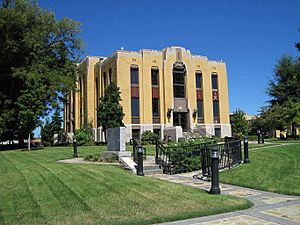Lauderdale County, Tennessee facts for kids
Quick facts for kids
Lauderdale County
|
|||
|---|---|---|---|

Lauderdale County Courthouse in Ripley
|
|||
|
|||

Location within the U.S. state of Tennessee
|
|||
 Tennessee's location within the U.S. |
|||
| Country | |||
| State | |||
| Founded | 1835 | ||
| Named for | James Lauderdale | ||
| Seat | Ripley | ||
| Largest city | Ripley | ||
| Area | |||
| • Total | 508 sq mi (1,320 km2) | ||
| • Land | 472 sq mi (1,220 km2) | ||
| • Water | 36 sq mi (90 km2) 7.0%% | ||
| Population
(2020)
|
|||
| • Total | 25,143 |
||
| • Density | 59/sq mi (23/km2) | ||
| Time zone | UTC−6 (Central) | ||
| • Summer (DST) | UTC−5 (CDT) | ||
| Congressional district | 8th | ||
Lauderdale County is a county located in the western part of Tennessee, right next to the Mississippi River. In 2020, about 25,143 people lived here. The main town and county seat (where the county government is) is Ripley. For a long time, especially before the American Civil War, this area was known for growing a lot of cotton.
Contents
History of Lauderdale County
Lauderdale County was created in 1835. It was formed from parts of other nearby counties: Tipton, Dyer, and Haywood. The county was named after Lieutenant Colonel James Lauderdale. He was a brave soldier who died during the War of 1812 at the Battle of New Orleans.
In the early days, many large farms, called plantations, were set up along the rivers. These farms grew a lot of cotton, which was a very important crop. Enslaved African Americans were forced to work on these plantations. After the American Civil War, slavery ended. Many formerly enslaved people, now called freedmen, stayed in the area. They often worked on the land as sharecroppers or tenant farmers. This meant they rented land and paid with a share of their crops.
After the war, and especially after a period called Reconstruction, white people in the area used violence to try and control Black people. This was part of a system called white supremacy, where white people believed they were superior and tried to keep Black people from having equal rights.
The Battle of Fort Pillow
In 1861, during the American Civil War, the Confederate States Army built strong defenses in Lauderdale County. These defenses were along the Mississippi River and were named Fort Pillow, after General Gideon J. Pillow. This fort was very important because of its location.
By 1864, the Union Army had taken control of the fort. In April of that year, Confederate soldiers attacked Fort Pillow. The Union defenders were a mix of white and Black soldiers. Many of the Black soldiers were part of the United States Colored Troops (USCT), which were made up of formerly enslaved people who had joined the Union Army.
During the battle, the Confederates took over the fort. There are different stories about what happened next. Some say the Union soldiers refused to give up, but others disagree. What is known is that many Union soldiers, especially the Black soldiers, were killed even after the fighting was mostly over. People in the North were very upset by this event and called it a massacre. After this, Black soldiers in the Union Army would sometimes shout, "Remember Fort Pillow!" as a rallying cry during battles.
Today, you can visit Fort Pillow State Park. It has a museum that tells the story of the battle. You can also see reconstructed parts of the fort there.
Geography of Lauderdale County
Lauderdale County covers a total area of about 508 square miles. Most of this is land (472 square miles), and about 36 square miles (7.0%) is water. The western border of the county is the mighty Mississippi River. To the north, the Forked Deer River forms the border with Dyer County. To the south, the Hatchie River forms the border with Haywood County.
Lauderdale County is located near the edge of the New Madrid Seismic Zone. This area has a higher risk of earthquakes than many other places.
Neighboring Counties
- Dyer County (north)
- Crockett County (east)
- Haywood County (southeast)
- Tipton County (south)
- Mississippi County, Arkansas (west)
Protected Natural Areas
- Chickasaw National Wildlife Refuge
- Lower Hatchie National Wildlife Refuge (part of it)
State Parks and Historic Sites
- Cold Creek Wildlife Management Area
- Fort Pillow State Park
- Alex Haley House and Museum (a state historic site)
- Sunk Lake State Natural Area
- John Tully State Forest
- John Tully Wildlife Management Area
Main Roads
- Future Interstate 69
- U.S. Highway 51
- Tennessee State Route 19 (also known as Tina Turner Highway)
- Tennessee State Route 87
- Tennessee State Route 88
- Tennessee State Route 180
- Tennessee State Route 181
- Tennessee State Route 371
Population Facts
| Historical population | |||
|---|---|---|---|
| Census | Pop. | %± | |
| 1840 | 3,435 | — | |
| 1850 | 5,169 | 50.5% | |
| 1860 | 7,559 | 46.2% | |
| 1870 | 10,838 | 43.4% | |
| 1880 | 14,918 | 37.6% | |
| 1890 | 18,756 | 25.7% | |
| 1900 | 21,971 | 17.1% | |
| 1910 | 21,105 | −3.9% | |
| 1920 | 21,494 | 1.8% | |
| 1930 | 23,406 | 8.9% | |
| 1940 | 24,461 | 4.5% | |
| 1950 | 25,047 | 2.4% | |
| 1960 | 21,844 | −12.8% | |
| 1970 | 20,271 | −7.2% | |
| 1980 | 24,555 | 21.1% | |
| 1990 | 23,491 | −4.3% | |
| 2000 | 27,101 | 15.4% | |
| 2010 | 27,815 | 2.6% | |
| 2020 | 25,143 | −9.6% | |
| U.S. Decennial Census 1790-1960 1900-1990 1990-2000 2010-2020 2020 |
|||
2020 Census Information
In 2020, there were 25,143 people living in Lauderdale County. These people lived in 9,675 households, and 6,753 of these were families.
| Race | Num. | Perc. |
|---|---|---|
| White (non-Hispanic) | 15,016 | 59.72% |
| Black or African American (non-Hispanic) | 8,385 | 33.35% |
| Native American | 133 | 0.53% |
| Asian | 53 | 0.21% |
| Other/Mixed | 969 | 3.85% |
| Hispanic or Latino | 587 | 2.33% |
Culture and People
Sleepy John Estes
Sleepy John Estes was a famous American blues guitarist, songwriter, and vocalist. He was born in Ripley, Tennessee. Sleepy John Estes passed away on June 5, 1977. He is buried at Elam Baptist Church Cemetery in Durhamville, which is in Lauderdale County.
Veterans' Museum in Halls
The Veterans' Museum is located in Halls. It's on the grounds of what used to be the Dyersburg Army Air Base. This museum works to save and share information about military activities. It covers wars and conflicts from World War I up to today. It also tells the story of the old air base itself.
Communities in Lauderdale County
Cities
- Ripley (This is the county seat)
Towns
Other Communities
- Arp
- Cherry
- Durhamville
- Fulton
- Glimp
- Golddust
- Orysa
Education
All schools in Lauderdale County are part of the Lauderdale County School District.
Famous People from Lauderdale County
- Sleepy John Estes – A blues guitarist born in Ripley.
- Alex Haley – The author of the famous book Roots.
- Jim Hickman – A professional baseball All-Star player.
- Miles O'Keeffe – An actor known for movies like Tarzan, the Ape Man.
- Cary Middlecoff – A professional golfer known as “Mr. 59” for his low score in a PGA event. He was born in Halls, Tennessee.
Images for kids
-
A-7 Corsair II airplane in front of the Veterans' Museum in Halls (2006).
-
Alex Haley's childhood home in Henning (2007).
See also
 In Spanish: Condado de Lauderdale (Tennessee) para niños
In Spanish: Condado de Lauderdale (Tennessee) para niños






